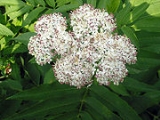
Danewort
Encyclopedia
Danewort also known as Dane Weed, Danesblood, Dwarf Elder or European Dwarf Elder and Walewort is a herbaceous
species of elder
, native to southern and central Europe
and southwest Asia
. It grows to 1-2 m tall, with erect, usually unbranched stems growing in large groups from an extensive perennial underground rhizome
. The leaves
are opposite, pinnate, 15-30 cm long, with 5-9 leaflets with a foetid smell. The stems terminate in a corymb 10-15 cm diameter with numerous white (occasionally pink) flower
s. The fruit
is a small glossy black berry
5-6 mm diameter. The ripe fruit give out a purple juice.
The name Danewort comes from the belief that it only grows on the sites of battles that involved the Danes. The term 'Walewort' or 'Walwort' meant 'foreigner plant.' The plant's stems and leaves turn red in autumn and this may explain the link with blood. The word Dane may link to an old term for diarrhoea.
Herbaceous
A herbaceous plant is a plant that has leaves and stems that die down at the end of the growing season to the soil level. They have no persistent woody stem above ground...
species of elder
Elderberry
Sambucus is a genus of between 5 and 30 species of shrubs or small trees in the moschatel family, Adoxaceae. It was formerly placed in the honeysuckle family, Caprifoliaceae, but was reclassified due to genetic evidence...
, native to southern and central Europe
Europe
Europe is, by convention, one of the world's seven continents. Comprising the westernmost peninsula of Eurasia, Europe is generally 'divided' from Asia to its east by the watershed divides of the Ural and Caucasus Mountains, the Ural River, the Caspian and Black Seas, and the waterways connecting...
and southwest Asia
Asia
Asia is the world's largest and most populous continent, located primarily in the eastern and northern hemispheres. It covers 8.7% of the Earth's total surface area and with approximately 3.879 billion people, it hosts 60% of the world's current human population...
. It grows to 1-2 m tall, with erect, usually unbranched stems growing in large groups from an extensive perennial underground rhizome
Rhizome
In botany and dendrology, a rhizome is a characteristically horizontal stem of a plant that is usually found underground, often sending out roots and shoots from its nodes...
. The leaves
Leaf
A leaf is an organ of a vascular plant, as defined in botanical terms, and in particular in plant morphology. Foliage is a mass noun that refers to leaves as a feature of plants....
are opposite, pinnate, 15-30 cm long, with 5-9 leaflets with a foetid smell. The stems terminate in a corymb 10-15 cm diameter with numerous white (occasionally pink) flower
Flower
A flower, sometimes known as a bloom or blossom, is the reproductive structure found in flowering plants . The biological function of a flower is to effect reproduction, usually by providing a mechanism for the union of sperm with eggs...
s. The fruit
Fruit
In broad terms, a fruit is a structure of a plant that contains its seeds.The term has different meanings dependent on context. In non-technical usage, such as food preparation, fruit normally means the fleshy seed-associated structures of certain plants that are sweet and edible in the raw state,...
is a small glossy black berry
Berry
The botanical definition of a berry is a fleshy fruit produced from a single ovary. Grapes are an example. The berry is the most common type of fleshy fruit in which the entire ovary wall ripens into an edible pericarp. They may have one or more carpels with a thin covering and fleshy interiors....
5-6 mm diameter. The ripe fruit give out a purple juice.
The name Danewort comes from the belief that it only grows on the sites of battles that involved the Danes. The term 'Walewort' or 'Walwort' meant 'foreigner plant.' The plant's stems and leaves turn red in autumn and this may explain the link with blood. The word Dane may link to an old term for diarrhoea.

